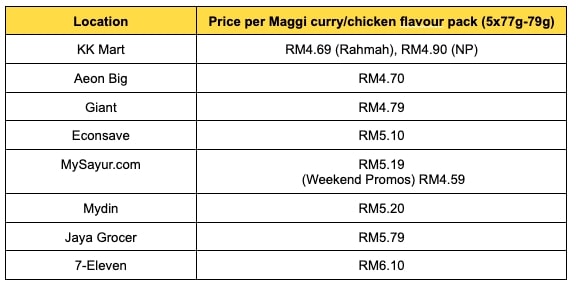KUALA LUMPUR – A plate of “Maggi goreng” (fried instant noodles) is indeed cheaper to cook at home than to buy and consume at eateries, based on a comparison of prices for the dish and the cost of ingredients required to make it.
While Economy Minister Rafizi Ramli and Rawang assemblyman Chua Wei Kiat may be correct on the price per plate, there are other factors coming into play to determine if busy Malaysians will find it worthwhile to spend their time preparing the dish themselves.
Scoop visited several “mamak” (Indian-Muslim) eateries and found that single portions of “Maggi goreng biasa” (basic fried instant noodle) were consistently priced below RM10.
Based on the survey, depending on location, the most expensive price for a portion was RM8.60, while the lowest price was RM5.28. It should be noted that certain prices are inclusive of tax.
The price differences may be attributed to the varying sizes of a portion and the use of different ingredients, besides other factors like overhead costs.

In terms of ingredients, while eggs and cabbage are almost must-haves in a plate of Maggi goreng, other add-ons are usually tofu, fritters or small amounts of chicken meat.
Compared to the cheapest price for a cooked plate of Maggi goreng (RM5.28), the price for a five-pack of uncooked Maggi noodles ranges between RM4.69 to RM6.10 in hypermarkets and convenience stores, or RM5.20 on average.

The average prices for other raw materials include RM14.10 for 30 eggs, RM9.40 per kg for chicken (under price control), RM8.86 for various vegetables, and 70 sen per fritter.
These figures were calculated according to prices acquired from four hypermarkets; Giant, Mydin, Jaya Grocer, and MySayur.com.
Even if each plate of home-cooked Maggi goreng with the above ingredients came up to around RM3.00 at cost, or RM90 for 30 plates, it is technically cheaper than dining outside.
However, the price per home-cooked meal is only applicable if one stretches the use of the ingredients. It is also unlikely that one would eat the same meal repeatedly.
It should also be noted that hidden costs would be present, such as expenses for gas, electricity, and labour.
Moreover, this comparison also only takes the price into account, without considering other factors such as convenience and time.
The cost of time and effort: worth it?
Finance executive Stanley Thas, 27, is one who prefers to cook at home, but admits that he was still surprised at the spike of grocery prices.
He said that if he eats Maggi goreng at a restaurant, he pays between RM5 to RM6 for a plate. Anything more than that is unaffordable, he told Scoop.
“I’d prefer to cook this food by myself, especially the ‘Mi Sedaap’ packets, as it’s very easy to make.
“Even so, the recent price of groceries shocks me,” said Thas, who felt that local food prices can be cheaper if agriculture is supported with more subsidies and jobs in the sector are made more attractive to youths.

Sales and business executive Aleyzar Azmi, 30, meanwhile, agreed with the cost savings from cooking and eating at home.
She said RM7 to RM8 for a plate of Maggi goreng biasa is expensive, since a five-pack of the instant noodles or a packet of bihun (rice vermicelli noodles) is around RM4 or RM5.
“I can feed five to six people rather than paying for one plate of it for RM7,” she said.

Yiaw Sam Lee, 26, however, prizes convenience and time saved over food costs, due to the busy nature of his work as an information technology (IT) consultant.
“Eating out everyday isn’t affordable at all. This year alone, restaurants have increased their prices twice.
“When you’re working, in the afternoon, you need to eat at the restaurant. If I can, I’ll cook for myself for dinner,” he said.
Last month, Economy Minister Rafizi Ramli said Malaysians were “addicted” to dining outside since they spend a large sum of their salaries on it.
“When it comes to inflation, it looks healthy. It’s about 2%, 2.5%.
“But by and large, the public feels that it just cannot be right because they feel that they don’t have enough at month-end,” Rafizi had said.
Rafizi received some brickbats, leading Chua to defend him by posting on Facebook that it cost RM5 for consumers to eat a bowl of Maggi outside. He then compared this with the price of a package of five Maggi packets, which was RM4.80. – October 31, 2023


